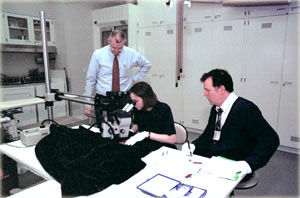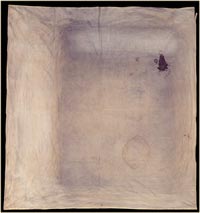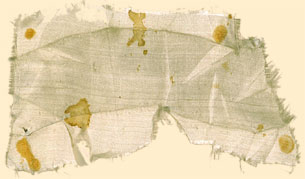
Iron was commonly used as an additive with natural dyes to achieve dark blue and black colors. Silks were often sold by weight during the second half of the nineteenth century and manufacturers frequently added extra iron during the dying and finishing process to increase the weight and price of their fabrics, a practice called "weighting." Silk with a high iron content deteriorates rapidly and excessive silk weighting was prohibited by the early twentieth century.
Microscopists at the McCrone Research Institute hope to determine if the heavy soiling on the sheet could have been deposited at a Washington D.C. boarding house, during exhibition at Chicago's Libby Prison Civil War Museum, or at Omaha's 1899 Greater America Exposition. Dust samples from Abraham Lincoln's alleged deathbed sheet were collected with soluble tape, a nondestructive sampling technique that removes only microscopic quantities. The samples will be analyzed for particle composition, including soil, settled dust, and pollen. This evidence can be linked to a specific geographic region.


Oily gray stains suggest that one side was worn close to the skin. Mirror image stains reveal that it was folded along the edges; the blood seeped through the top layer of fabric to create a matching stain on the layer below. One stain abruptly ends at the edge of a stitch hole, where the blood wicked along a sewing thread that is now missing. There is an impression of a weave pattern in the stain that does not correspond with the underlying textile, indicating that a second fabric was pressed on top of it. A single red fiber embedded in the blood stain may have come from the outer fabric of this garment.

Principal investigators at the University of Illinois at Chicago and McCrone Research Institute have begun a material analysis of the Lincoln relics .
Fibers in the textile artifacts have been identified to help researchers match and date the evidence. The cloak lining fibers are badly deteriorated, providing a clue to their date of manufacture. Elemental analysis of the fibers by a scanning electron microscope with an energy dispersive X-ray detector indicates a high iron content. (WANAT 52)



Watch a microscopist examine staining patterns on a Lincoln relic!
You will need QuickTime installed on your computer to watch the video. Click here to download and install QuickTime
Stained dress fragment attributed to Clara Harris. (CHS XA-1205)
Choose the option below that matches your Internet connection.